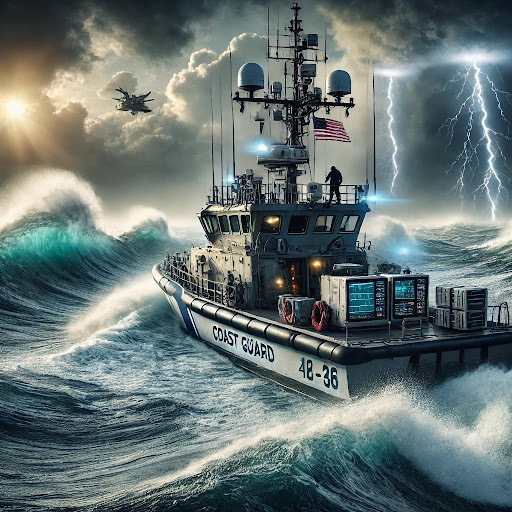The Coast Guard operates in some of the most extreme environments on the planet, from turbulent seas and icy waters to hurricane-force winds and blinding snowstorms. Their missions are critical, ranging from search and rescue operations to environmental protection and national security. To perform these vital tasks effectively, the Coast Guard relies on an array of advanced technologies designed to withstand the harshest conditions. This article explores the essential technology that empowers the Coast Guard to survive and thrive in extreme environments.
Navigational Technology
Navigational technology is at the heart of the Coast Guard's ability to operate in extreme conditions. Accurate navigation is crucial for safely maneuvering through treacherous waters and reaching those in need.
Advanced GPS Systems
Global Positioning System (GPS) technology is indispensable for the Coast Guard. Advanced GPS systems provide precise location data, enabling vessels to navigate accurately even in poor visibility. These systems are integrated into the Coast Guard's ships and aircraft, ensuring they can maintain their course and arrive at their destinations efficiently.
Electronic Chart Display and Information Systems (ECDIS)
ECDIS is a sophisticated navigation system that combines GPS data with electronic nautical charts. This technology provides real-time updates on the vessel's position, potential hazards, and environmental conditions. ECDIS enhances situational awareness, helping the Coast Guard avoid obstacles and navigate safely through challenging waters.
Radar and Sonar
Radar and sonar systems are essential for detecting objects and terrain features that are not visible to the naked eye. Radar systems are used to identify other vessels, landmasses, and weather formations, while sonar systems detect underwater obstacles and map the seafloor. These technologies are crucial for safe navigation and search and rescue operations.
Communication Systems
Effective communication is vital for coordinating missions and ensuring the safety of Coast Guard personnel. In extreme environments, robust communication systems are necessary to maintain contact with headquarters, other vessels, and rescue teams.
Satellite Communications
Satellite communication systems provide reliable, long-range communication capabilities, even in remote areas where traditional radio signals might fail. These systems enable the Coast Guard to transmit and receive data, voice communications, and video feeds, ensuring seamless coordination during missions.
HF/VHF/UHF Radios
High Frequency (HF), Very High Frequency (VHF), and Ultra High Frequency (UHF) radios are used for short and medium-range communication. These radios are essential for coordinating with nearby vessels, aircraft, and ground teams. The Coast Guard uses encrypted radio channels to maintain secure communications during sensitive operations.
Rugged Monitors and Devices
A rugged monitor or device is designed to withstand harsh conditions, including extreme temperatures, moisture, and physical impacts. These durable devices are used in control rooms, on decks, and in aircraft cockpits to display vital information and facilitate real-time decision-making. Their durability ensures that critical data is always accessible, regardless of the environment.
Search and Rescue Technology
Search and rescue (SAR) operations are a core mission of the Coast Guard, often conducted in life-threatening conditions. Advanced SAR technology is essential for locating and rescuing individuals quickly and efficiently.
Aerial Drones
Aerial drones are increasingly used in SAR missions to provide aerial surveillance and assess situations from above. Equipped with high-resolution cameras and thermal imaging, drones can locate missing persons, assess damage, and provide real-time footage to rescue teams. Their ability to operate in harsh weather conditions makes them invaluable for SAR operations.
Thermal Imaging Cameras
Thermal imaging cameras detect heat signatures, making them ideal for locating individuals in low visibility conditions such as fog, smoke, or darkness. These cameras are mounted on helicopters, drones, and rescue vessels, allowing the Coast Guard to identify people in distress and navigate through challenging environments.
Rescue Swimmers and Equipment
Coast Guard rescue swimmers are highly trained to perform rescues in extreme conditions. They use specialized equipment such as dry suits, fins, and flotation devices to ensure their safety and the safety of those they are rescuing. Additionally, the use of hoists and baskets enables safe extraction from the water or stranded vessels.
Environmental Monitoring
The Coast Guard also plays a critical role in environmental protection, including monitoring pollution and responding to environmental disasters. Advanced environmental monitoring technology helps the Coast Guard detect and mitigate environmental hazards.
Oil Spill Detection Systems
Oil spill detection systems use satellite imagery, aerial surveillance, and remote sensing technology to identify oil spills quickly. These systems provide real-time data on the location, size, and spread of oil spills, enabling the Coast Guard to respond promptly and effectively.
Water Quality Sensors
Water quality sensors are deployed to monitor pollutants and assess the health of marine ecosystems. These sensors measure parameters such as temperature, salinity, pH, and the presence of contaminants. The data collected helps the Coast Guard make informed decisions about environmental protection and remediation efforts.
Ice Detection and Monitoring
In polar regions, ice detection and monitoring systems are crucial for safe navigation and environmental protection. These systems use radar, sonar, and satellite imagery to detect and track ice formations, providing real-time information to vessels operating in icy waters. This technology is essential for avoiding collisions with icebergs and ensuring safe passage through ice-covered areas.
Weather Forecasting and Monitoring
Accurate weather forecasting and monitoring are vital for the Coast Guard to plan and execute missions safely. Extreme weather conditions pose significant risks, and advanced meteorological technology helps mitigate these dangers.
Satellite Weather Systems
Satellite weather systems provide comprehensive data on weather patterns, including storms, hurricanes, and other extreme weather events. These systems offer real-time updates and detailed forecasts, enabling the Coast Guard to anticipate and respond to adverse weather conditions.
Doppler Radar
Doppler radar is used to monitor precipitation, wind speed, and storm movement. This technology provides critical information for predicting severe weather and planning rescue operations. Doppler radar helps the Coast Guard track hurricanes, monitor storm surges, and issue timely warnings to vessels at sea.
Automated Weather Stations
Automated weather stations are deployed on land, at sea, and in the air to collect real-time weather data. These stations measure temperature, humidity, wind speed, and atmospheric pressure. The data collected is used to create accurate weather forecasts and inform decision-making during missions.
Overcoming Operational Challenges
The Coast Guard faces numerous operational challenges when working in extreme environments. Here are some of the key obstacles and the technology used to overcome them:
Extreme Temperatures: Specialized equipment like rugged monitors and climate-controlled gear ensures functionality and safety in harsh weather.
Limited Visibility: Advanced radar, sonar, and thermal imaging cameras provide critical visibility in low-light and adverse weather conditions.
Communication Breakdowns: Satellite communications and encrypted radios maintain reliable connections, even in remote and challenging areas.
Navigational Hazards: ECDIS, GPS, and ice detection systems help navigate safely through treacherous waters and ice-covered regions.
Data Security: Robust cybersecurity measures protect sensitive information and ensure secure communication during missions.
Conclusion
The Coast Guard's ability to operate in extreme environments relies on a sophisticated array of technologies designed to enhance navigation, communication, search and rescue, environmental monitoring, and weather forecasting. These advanced tools and systems enable the Coast Guard to perform their critical missions effectively, ensuring the safety and security of those at sea and protecting the marine environment. As technology continues to evolve, the Coast Guard will continue to adopt and integrate new innovations, maintaining their readiness and resilience in the face of ever-changing challenges.


















